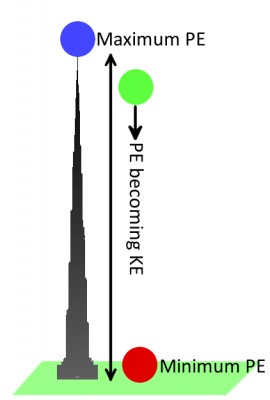What is Electricity?
Electric Potential (Energy)
When we harness electricity to power our circuits, gizmos, and gadgets, we're really transforming energy. Electronic circuits must be able to store energy and transfer it to other forms like heat, light, or motion. The stored energy of a circuit is called electric potential energy.
Energy? Potential Energy?
To understand potential energy we need to understand energy in general. Energy is defined as the ability of an object to do work on another object, which means moving that object some distance. Energy comes in many forms, some we can see (like mechanical) and others we can't (like chemical or electrical). Regardless of what form it's in, energy exists in one of two states: kinetic or potential.
An object has kinetic energy when it's in motion. The amount of kinetic energy an object has depends on its mass and speed. Potential energy, on the other hand, is a stored energy when an object is at rest. It describes how much work the object could do if set into motion. It's an energy we can generally control. When an object is set into motion, its potential energy transforms into kinetic energy.
Let's go back to using gravity as an example. A bowling ball sitting motionless at the top of Khalifa tower has a lot of potential (stored) energy. Once dropped, the ball--pulled by the gravitational field--accelerates towards the ground. As the ball accelerates, potential energy is converted into kinetic energy (the energy from motion). Eventually all of the ball's energy is converted from potential to kinetic, and then passed on to whatever it hits. When the ball is on the ground, it has a very low potential energy.
Electric Potential Energy
Just like mass in a gravitational field has gravitational potential energy, charges in an electric field have an electric potential energy. A charge's electric potential energy describes how much stored energy it has, when set into motion by an electrostatic force, that energy can become kinetic, and the charge can do work.
Like a bowling ball sitting at the top of a tower, a positive charge in close proximity to another positive charge has a high potential energy; left free to move, the charge would be repelled away from the like charge. A positive test charge placed near a negative charge would have low potential energy, analogous to the bowling ball on the ground.
To instill anything with potential energy, we have to do work by moving it over a distance. In the case of the bowling ball, the work comes from carrying it up 163 floors, against the field of gravity. Similarly, work must be done to push a positive charge against the arrows of an electric field (either towards another positive charge, or away from a negative charge). The further up the field the charge goes, the more work you have to do. Likewise, if you try to pull a negative charge away from a positive charge--against an electric field--you have to do work.
For any charge located in an electric field its electric potential energy depends on the type (positive or negative), amount of charge, and its position in the field. Electric potential energy is measured in units of joules (J).
Electric Potential
Electric potential builds upon electric potential energy to help define how much energy is stored in electric fields. It's another concept which helps us model the behavior of electric fields. Electric potential is not the same thing as electric potential energy!
At any point in an electric field the electric potential is the amount of electric potential energy divided by the amount of charge at that point. It takes the charge quantity out of the equation and leaves us with an idea of how much potential energy specific areas of the electric field may provide. Electric potential comes in units of joules per coulomb (J/C), which we define as a volt (V).
In any electric field there are two points of electric potential that are of significant interest to us. There's a point of high potential, where a positive charge would have the highest possible potential energy, and there's a point of low potential, where a charge would have the lowest possible potential energy.
One of the most common terms we discuss in evaluating electricity is voltage. A voltage is the difference in potential between two points in an electric field. Voltage gives us an idea of just how much pushing force an electric field has.
With potential and potential energy under our belt we have all of the ingredients necessary to make current electricity. Let's do it!

